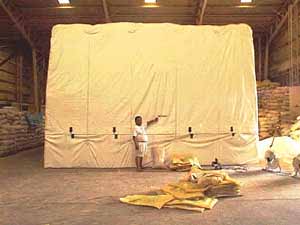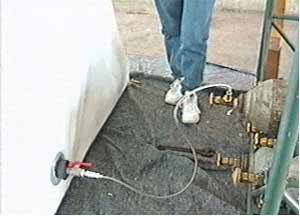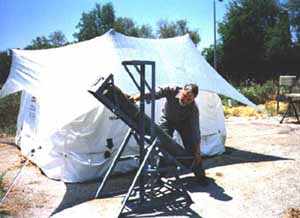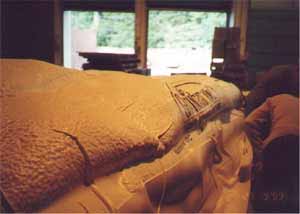

 |
 |
The "hermetic" approach to the design of a storage structure has all the advantages of enabling grain to be protected from pests without employing pesticides. It relies on the principle that when grain is taken into storage it is nearly always already infested with stored-product insects that are the main source of losses to grain in warm climates. In the past, hermetic storage has been difficult to apply in practice because, the smaller the storage structure, the more critical is the importance of the hermetic seal, and the more expensive and difficult it is per unit of storage capacity to obtain the required gas tightness. This has often been the stumbling block, both for modification of traditional storage structures, and for the introduction of new ones to the village farmer.
However, with recent advances in plastic manufacture, we have worked in cooperation with the plastics industry to develop a liner that meets the pre-requisites needed to provide a sufficiently tight hermetic seal to preserve the grain for prolonged periods.
The original initiative to develop the GrainPro Cocoon stems from a joint effort by the American Jewish World Service, (a US based NGO), and the SARVODIA Movement of Sri Lanka, to improve the level of food security for the rural communities of Sri Lanka. For this we are grateful to Prof. Laurence Simon, founder of AJWS, and later, founder of GrainPro, an NGO devoted to the improvement of storage technologies in the less-developed countries and now heaed by Dr. Phillipe Villers.
The cocoons are designed to be set up out in the open and straight on the ground, with multiple usage over a long time period, and under far from optimal conditions. This is achieved by use of a heavy-duty liner made up of two sections, that are UV protected, food-grade and with a proven life of the material of many years under our own extreme conditions of desert climate. Ideally they can be used when and where no suitable storage structure is available, though they can also be placed inside existing storage structures if preferred.

The cocoon is provided with a light carrying bag in which it can be stored and protected from rodent attack when not in use. To load the grain, the lower-section is laid on the ground and the bags of grain are placed directly on the liner. If storage is outdoors it has been found convenient to spread a layer of rice husk ash when available over the ground beforehand. This serves to provide a soft base without sharp projections and may even have an abrasive insecticidal effect against ants and termites. Pallets which the farmers do not normally have, are not required, since the liner itself forms a barrier preventing moisture migration from the ground. The underliner dimensions determine the size of the stack to be built. After the stack has been built to the required height, the overliner is then placed over the top of the stack and meets the underliner half way up the side. The underliner and overliner are provided with a gastight multiple tongue and groove zipper, which is then used to zip them together to form a continuous envelope
The cocoons are modular, being fabricated in 5, 10, 20 and 50 ton capacity sizes, with dimensions chosen to make normal stacking and sealing easy, - two metres high, and the zipper situated half way up the stack.

More recently cocoons have been used very succesfully by the National Food Authority (NFA) in the Philippines to store milled rice with dimensions to enclose 150 ton stacks.
The bags should be stacked criss-cross, and a final layer is laid along the center line to produce a watershedd effect when the overliner is spread over the stack. This prevents rainwater pools from collecting on the upper surface
The special tension straps situated around the cocoon are designed to take-up slack in the walls and pull the liner tight around the curve of the sacks at floor level. When this is done, it has been repeatedly shown that rodents do not penetrate the cocoons or damage the hermetic seal. It would appear that the rodents are unable to gain a toothhold on the slippery PVC surface, and this has been confirmed in laboratory trials with rats and house-mice.
The liner material has been laboratory tested extensively for penetration by stored product insects, and has shown to be highly resistant to even the most effective "penetrator" The lesser grain borer Rhizopertha dominica. Field tests in termite infested areas have failed to reveal termite damage to the liner.
These GrainPro Cocoons™, have been extensively tested in Israel, Sri Lanka, The Philippines, Thailand and other countries, over the course of about 20 years using different commodities. These trials have been instructive in adapting the technology to local needs.
A major advantage of the cocoons is that they can be used to safely store grain outdoors when no suitable storage buildings are available. However, under tropical conditions, when grain is stored in the open with no shade, ambient diurnal temperature fluctuations, can create temperature gradients within the stack that cause convection currents to carry moisture to the upper layers of grain. To overcome this, an upper insulating layer of bags containing straw or husks was employed. Under Filipino conditions this solution enabled safe storage of maize and paddy for periods of up to three months, while for more extended periods the top moistened layer of husks had to be replaced with dry material. This method, although solving the problem, suffered from the inherent disadvantages of reduction in effective storage capacity, the necessity to procure and transport material to fill the bags, and the added expense of bags not used for storing grain.

In a search to develop an alternative inexpensive and convenient method of insulating the stack from diurnal temperature fluctuations, the use of a shade screen placed above the cocoon was investigated. This material is a knitted thermal screen formed from aluminum coated high density polyethylene threads.
Trials in Israel and the Philippines showed that the reflective covers had a strong attenuating influence on temperature gradients and condensation at the top of the cocoons on condition that a space for free movement of air was allowed between the cover and the plastic liner. For dry paddy, it was shown that after five months storage under a reflective cover, no perceptible increase in moisture content was found at the top of the stack and the grain remained in good condition. Consequently the thermal screen has been included as standard in the kit of the carrying bag. Of course, for indoor storage no such protection is required.
A series of trials have recently been carried out in the Philippines using intermediate moisture content paddy (14-18% MC). The objective was to provide temporary protection when crops are harvested during the monsoon season. For more info, go to the executive summary of the published report.
Q: Are the cocoons suitable for seed storage??
A: In our own scientific reports on storage of dry paddy and maize in Grainpro cocoons in the Philippines, no decrease in viability of the paddy and maize over storage periods of four months and six months respectively, was recorded.
Similarly barley stored in hermetically sealed bunkers in Cyprus retained 88% germination after 34 months storage, while wheat stored in a plastic silo in Israel for 48 months averaged initial germination of 99.5% and final germination of 96.9%.
These findings are corroborated by almost all other publications on this subject in the literature. This can be verified in a recent overview on the influence of controlled atmospheres (including hermetic storage) on grain quality entitled "Quality changes in grain under controlled atmosphere storage" by N.D.G. White and D.S.Jayas (Proc. Int. Conf. Controlled Atmosphere and Fumigation in Grain Storages, Winnipeg Canada June 1992, Caspit Press Ltd. Jerusalem pp. 205-214:), and they reinforce the conclusions of an earlier review by J.H. Banks ("Effects of controlled atmosphere storage on grain quality: a review. Food Technol. Australia 33, pp 335-340.) The overall findings of other researchers is that hermetic storage does not impair germination of seeds, but compares favorably with other storage methods.
Although only some of the seed grains have been studied under hermetic storage, and there may be exceptions that have not yet been revealed, it can be safely said that in general, the preservation of the quality and germination of grain can be maintained under hermetic conditions as long as the grain remains dry.
Q: Are not the cocoons susceptible to thievery since the plastic can easily be slashed??
A: Yes, but no more-so than a conventional warehouse, where the lock has to be picked. The problem is not getting at the grain but rather in having the means to haul it away. In both cases where security is a problem the necessary precautionary measures should be taken. A slashed cocoon can easily be repaired with the repair kit provided.
Q:How about rodents? Our rodents are bigger and more ferocious than yours!
A:Maybe, but if you pull up the liner slack from the ground using the tension straps, rodent attack is very rare indeed. Our lab trials with wild rats and mice have found that their inscisors slide over the slippery surface, and when eventually a hungry rodent manages to penetrate the PVC pouch to get at the grain inside, it is the little house-mouse and not the Norway or Oriental rat that succeeds!
These modules are designed for non toxic MA fumigation and the safe storage of high value, durable, agricultural commodities.
 They can be tailor made to encompass stacks of boxed, crated or packaged produce. After the commodity is loaded into the module it is sealed, and carbon dioxide (CO2) or nitrogen (N2) is flushed into the enclosed space.
They can be tailor made to encompass stacks of boxed, crated or packaged produce. After the commodity is loaded into the module it is sealed, and carbon dioxide (CO2) or nitrogen (N2) is flushed into the enclosed space.
In the case of CO2 fumigation, the CO2 is best introduced in the liquid phase at a gas inlet valve situated at the bottom, and displaces the air in the storage module upwards, where it is released to the atmosphere through a top outlet port. The amount of CO2 introduced is calculated to enable an initial concentration of 80% to be reached within the storage module. This dosage will kill all stages of living stored-product insects, including eggs within a maximum exposure time of 15 days.
This fumigation time-frame is for treatments in warm climates or where temperatures are above 20oC. At higher temperatures the CO2 enriched and O2 impoverished atmosphere kills insects more rapidly than at lower ones, and below about 20oC mortality becomes more prolonged.
 Since there is a direct relationship between the CO2 and O2 concentrations within the storage module, the CO2 concentration can be easily monitored and controlled indirectly using a portable O2 meter, or directly, using a CO2 meter.
Since there is a direct relationship between the CO2 and O2 concentrations within the storage module, the CO2 concentration can be easily monitored and controlled indirectly using a portable O2 meter, or directly, using a CO2 meter.
For nitrogen fumigation the application method is similar but the N2 is released in the gaseous phase. Also a higher (98%) concentration of N2 must be maintained in the storage module since in this case it is the lack of O2 (hypoxia) that kills the insects whereas for CO2 fumigation, both the high CO2 concentration (hypercarbia) and low O2 concentration have a combined lethal effect.
This technology is suitable for an increasing number of situations where methyl bromide and/or phostoxin are excluded from use as fumigants for environmental or health-food reasons.
For prolonged storage of high value commodities: Many durable commodities are subject to oxidative changes during storage that have an adverse effect on colour, taste aroma or nutritive value. In contrast, storage under modified atmospheres whereby the oxygen in the air surrounding the commodity is replaced by either carbon dioxide or nitrogen, prevents both the development of insects and the oxidative processes within the commodity.

In this case, the method of applying the modified atmosphere is by the "flush and maintenance method". The cocoon/module is flushed from the bottom with carbon dioxide or nitrogen from tank or cylinders and the air is expelled from the top. Additional equipment provided to supply the modules as a turnkey project include a continuously operating oxygen monitor that measures concentrations of oxygen within the module, and when these rise above a pre-set limit the monitor activates a solenoid valve connected to a gas cylinder that injects gas into the module thereby maintaining the desired low oxygen concentration.
Recently the GrainPro Cocoons have been adapted for the insecticidal
treatment and storage for quality preservation under "Vacuum".  Follow this link to obtain info about this promising technology. We mention
it here because we have found that these cocoons can be purged with a vacuum pump
to reach extremely low pressures, and that these pressures can be retained indefinately
by intermitant action of the pump. Suffice to mention here that vacuum is only
effective if the pressures are extremely low since we have shown that the incecticidal
effect is due to the partial pressure of oxygen remaining in the container (hypoxia)
and not to the vacuum itself. Consequently it was previously supposed that these
treatments could only be carried out in chambers capable of withstanding the
pressures of implosion. However, with the cocoons, the elastic nature of the plastic
liners enable them to mould themselves to the profile of the sacks inside and
thereby retain the vacuum, so that the problem of building vacuum chambers no
longer exists.
Follow this link to obtain info about this promising technology. We mention
it here because we have found that these cocoons can be purged with a vacuum pump
to reach extremely low pressures, and that these pressures can be retained indefinately
by intermitant action of the pump. Suffice to mention here that vacuum is only
effective if the pressures are extremely low since we have shown that the incecticidal
effect is due to the partial pressure of oxygen remaining in the container (hypoxia)
and not to the vacuum itself. Consequently it was previously supposed that these
treatments could only be carried out in chambers capable of withstanding the
pressures of implosion. However, with the cocoons, the elastic nature of the plastic
liners enable them to mould themselves to the profile of the sacks inside and
thereby retain the vacuum, so that the problem of building vacuum chambers no
longer exists.
Donahaye, E., Ziv, A., Blauschild, Y., Navarro, S. and Weerasinghe, D. (1991). Storage of paddy in hermetically sealed plastic liners in Sri Lanka. Trop. Sci. 31: 109-121.
Donahaye, E. and Navarro, S. (1991). Final Report on Grain storage Project under agreement No. 846 between PERI/ARO and AJWS (1989-1991). Submitted to The American Jewish World Service. 78pp.

Donahaye, Andales, S., Navarro, S., Paster, N. Caliboso, F.M., and Sabio, G.C.(1999). Self regulated atmospheres to prevent fungal damage in moist paddy. Final Report submitted to U.S. Agency for International Development, CDR Project No. C12-057, January 1995 - November 1999. 32 pp.

Navarro S., Donahaye, E.J., Caliboso, F.M., and Sabio, G.C. (1998). Outdoor Storage of Corn and Paddy Using Sealed-Stacks in the Philippines. In: Proc. 18th ASEAN Seminar on Grains Postharvest Technology, 11-13 March 1997, Manila, Philippines pp. 225-236.
Donahaye, J.E., Navarro, S., Filipinas Caliboso, Glory Sabio, Gemma Mallo and Dator, J. (1999). Prevention of moisture migration in sealed stacks stored in the open in the tropics using reflective covers. 19th ASEAN Seminar on Postharvest Technology, Ho Chi Min City, Vietnam 9-12 Nov 1999 (accepted). 
Navarro, S. (2000). Appendix I- Vacuum and carbon dioxide treatments of cocoa. In. Storage of prunes under controlled atmospheres for quality preservation and insect control. Sabbatical Report 1998-1999 submitted to the USDA, ARS, Horticultural Crops Research Laboratory, Fresno, CA, 90-92.
Navarro, S., Donahaye, E., Rindner Miriam, Azrieli A. and Dias, R., (2001) Seed Storage In The Tropics Under Gastight Sealed Conditions. 20th ASEAN Seminar on Postharvest Technology, Chiang Mai, Thailand, September 2001. 
 |
 |
 |
 |
|---|